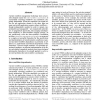Free Online Productivity Tools
i2Speak
i2Symbol
i2OCR
iTex2Img
iWeb2Print
iWeb2Shot
i2Type
iPdf2Split
iPdf2Merge
i2Bopomofo
i2Arabic
i2Style
i2Image
i2PDF
iLatex2Rtf
Sci2ools
134
click to vote
ICDE
2001
IEEE
2001
IEEE
Workflow and Process Synchronization with Interaction Expressions and Graphs
Current workflow management technology does not provide adequate means for inter-workflow coordination as concurrently executing workflows are considered completely independent. While this simplified view might suffice for one application domain or the other, there are many real-world application scenarios where workflows -though independently modeled in order to remain comprehensible and manageable -- are semantically interrelated. As pragmatical approaches, like merging interdependent workflows or inter-workflow message passing, do not satisfactorily solve the inter-workflow coordination problem, interaction expressions and graphs are proposed as a simple yet powerful formalism for the specification and implementation of synchronization conditions in general and inter-workflow dependencies in particular. In addition to a graph-based semi-formal interpretation of the formalism, a precise formal semantics, an equivalent operational semantics, an efficient implementation of the latter,...
Database | Graph-based Semi-formal Interpretation | ICDE 2001 | Interdependent Workflows | Real-world Application Scenarios |
| Added | 01 Nov 2009 |
| Updated | 01 Nov 2009 |
| Type | Conference |
| Year | 2001 |
| Where | ICDE |
| Authors | Christian Heinlein |
Comments (0)

